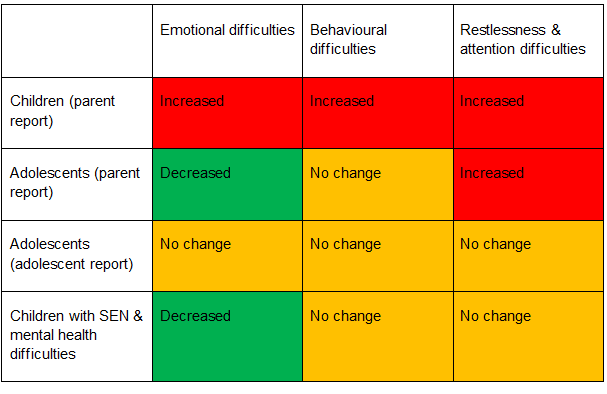A: It is likely that many children and adolescents are experiencing stress and mental health symptoms as a consequence of the pandemic, but we do not yet know the long term effects.
Here is what we do know:
-In the U.S. and in many parts of the world, children receive mental health support in school (up to 60% of those receiving mental health services). School closures have resulted in disruption to these services.
-Economic difficulty is a primary driver of worsening mental health symptoms for children and families; therefore we should be concerned about mental health in the context of economic losses related to the pandemic.
-Children with previously existing mental health symptoms are more likely to experience symptom exacerbation at this time.
In this context, recent studies suggest that:
1) Depression and anxiety may worsen while children and adolescents are in lockdown (China);
2) Depression and anxiety may decrease over time as we acclimate to conditions of lockdown or other restrictions although stress response related to these changes may stay the same or increase in severity (U.S.);
3) Young adults and families with young children may be most at risk of mental health symptoms (U.K.);
4) Young children may be most at risk of experiencing emotional difficulties, behavioral difficulties, and restlessness/attention difficulties during lockdown and school closures (U.K.).
The good news? Not all children will experience worsening mental health symptoms during this time. For those who are struggling, we can continue to support them in age appropriate ways as noted below.
• Younger children: Establish a new pandemic routine, Increase praise for good behaviors, and relax rules (within reason)
• School age children: Spend more time together, discuss age appropriate information, support relaxation and coping strategies, and encourage physical activity
• Tweens: Praise them for doing expected work, support good sleep hygiene, model good behavior (including stress management for adults), practice relaxation and coping strategies together, and encourage physical activity
• Teens: Plan positive activities (related to interests), encourage social connections (with appropriate physical distancing), encourage future planning (activities, trips, or college planning), and create space to be more independent
• For all children and adolescents: Limit electronics, limit news/media consumption, establish regular wake time, encourage social connections, and encourage diversity of activities (chores, school work, outside time, quiet time).
And for children and adolescents who are experiencing significant distress such that it impairs function and daily life and/or is unable to stay safe, it is important to seek additional support either through your local crisis services, primary care provider, or mental health specialist.
Stay safe. Stay sane. And continue to support yourself so that you can be there for the young people in your life.
~Aparna
Information/Studies highlighted:
The Lancet – Mental Health Effects of School Closures
PubMed Mental Health Status of Children in Confinement
The Lancet – Mental Health Before and During COVID-19
Additional Resources for Children, Adolescents, and Families:

Photo Credit: Oxford Co-SPACE Study


